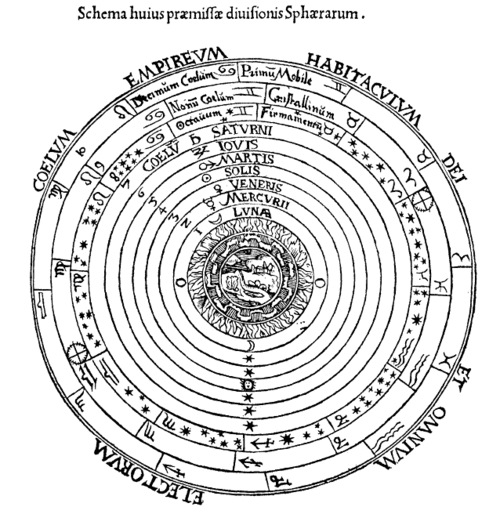Planetary sphere: Difference between revisions
No edit summary |
No edit summary |
||
| Line 1: | Line 1: | ||
[[File:Ptolemaicsystem-small.png|thumb|400px|Peter Apian, ''Cosmographia'', Antwerp 1524]] | [[File:Ptolemaicsystem-small.png|thumb|400px|Peter Apian, ''Cosmographia'', Antwerp 1524]] | ||
Seven '''planetary spheres''' ({{HeS|גַּלְגַּלים|[[Galgalim]]}}, [[Wikipedia:Singular|singular]] {{He|גַּלְגַּל}} ''Galgal'' "wheel"), which correspond to the classical [[seven planets]] and together form the [[Hebdomas]] ({{ELSalt|εβδομάς}} "sevenness"), surround the [[Earth]] in concentric circles from a [[geocentric worldview|geocentric]] point of view and constitute our present [[solar system]]. The actual reality of the planetary spheres is not on the outer [[physical plan]], but on the [[astral plan]]. Here, the planetary spheres, which partially interpenetrate each other, delimit the [[Dominions of the Hierarchies]] of the higher spiritual [[hierarchies]], which are connected with the [[earth evolution|earth evolution]] and [[human evolution]]. | Seven '''planetary spheres''' ({{HeS|גַּלְגַּלים|[[Galgalim]]}}, [[Wikipedia:Singular|singular]] {{He|גַּלְגַּל}} ''Galgal'' "wheel"), which correspond to the classical [[seven planets]] and together form the [[Hebdomas]] ({{ELSalt|εβδομάς}} "sevenness"), surround the [[Earth]] in concentric circles from a [[geocentric worldview|geocentric]] point of view and constitute our present [[solar system]]. The actual reality of the planetary spheres is not on the outer [[physical plan]], but on the [[astral plan]]. Here, the planetary spheres, which partially interpenetrate each other, delimit the [[Dominions of the Hierarchies]] of the higher spiritual [[hierarchies]], which are connected with the [[earth evolution|earth evolution]] and [[human evolution]]. | ||
== The planetary spheres and life between death and new birth == | |||
In the [[life between death and new birth]], the human being gradually wanders through the individual planetary spheres and stays there for a certain time in each case: | |||
{{GZ|On earth we live between birth and death. Between death and new birth, the human being is in a certain connection with the other planets. You will find the Kamaloka described in my "Theosophy". This stay of man in the world of the soul is a time during which man becomes a lunar dweller. Then he becomes a Mercury-dweller, then a Venus-dweller, then a Sun-dweller, a Mars-dweller, a Jupiter-dweller, a Saturn-dweller, and then a dweller in the wider celestial or world space. It is not incorrect to say that between two incarnations on Earth there are embodiments on other planets, spiritual embodiments. Man is not yet so far advanced in his development that he can remember in his incarnation what he has experienced between death and a new birth, but in the future this will be possible. Even if he cannot now remember what he experienced on Mars, for example, he still has the powers of Mars within him, even if he knows nothing about them. It is quite possible to say: Now I am an earthling, but the forces within me include something that I acquired on Mars.|130|318}} | |||
== Literature == | == Literature == | ||
Revision as of 17:38, 9 March 2021

Seven planetary spheres (Hebrew: גַּלְגַּלים Galgalim, singular גַּלְגַּל Galgal "wheel"), which correspond to the classical seven planets and together form the Hebdomas (Greek: εβδομάς "sevenness"), surround the Earth in concentric circles from a geocentric point of view and constitute our present solar system. The actual reality of the planetary spheres is not on the outer physical plan, but on the astral plan. Here, the planetary spheres, which partially interpenetrate each other, delimit the Dominions of the Hierarchies of the higher spiritual hierarchies, which are connected with the earth evolution and human evolution.
The planetary spheres and life between death and new birth
In the life between death and new birth, the human being gradually wanders through the individual planetary spheres and stays there for a certain time in each case:
„On earth we live between birth and death. Between death and new birth, the human being is in a certain connection with the other planets. You will find the Kamaloka described in my "Theosophy". This stay of man in the world of the soul is a time during which man becomes a lunar dweller. Then he becomes a Mercury-dweller, then a Venus-dweller, then a Sun-dweller, a Mars-dweller, a Jupiter-dweller, a Saturn-dweller, and then a dweller in the wider celestial or world space. It is not incorrect to say that between two incarnations on Earth there are embodiments on other planets, spiritual embodiments. Man is not yet so far advanced in his development that he can remember in his incarnation what he has experienced between death and a new birth, but in the future this will be possible. Even if he cannot now remember what he experienced on Mars, for example, he still has the powers of Mars within him, even if he knows nothing about them. It is quite possible to say: Now I am an earthling, but the forces within me include something that I acquired on Mars.“ (Lit.:GA 130, p. 318)
Literature
- Karl Erich Grözinger: Jüdisches Denken. Theologie - Philosophie - Mystik: Band 2: Von der mittelalterlichen Kabbala zum Hasidismus, Campus Verlag, Frankfurt/New York 2006, ISBN 978-3593375137
- Rudolf Steiner: Das esoterische Christentum und die geistige Führung des Menschen, GA 130 (1987), Neuchâtel, 18. Dezember 1912 English: rsarchive.org German: pdf pdf(2) html mobi epub archive.org
- Rudolf Steiner: Initiationswissenschaft und Sternenerkenntnis, GA 228 (2002), ISBN 3-7274-2280-7 English: rsarchive.org German: pdf pdf(2) html mobi epub archive.org
 |
References to the work of Rudolf Steiner follow Rudolf Steiner's Collected Works (CW or GA), Rudolf Steiner Verlag, Dornach/Switzerland, unless otherwise stated.
Email: verlag@steinerverlag.com URL: www.steinerverlag.com. Index to the Complete Works of Rudolf Steiner - Aelzina Books A complete list by Volume Number and a full list of known English translations you may also find at Rudolf Steiner's Collected Works Rudolf Steiner Archive - The largest online collection of Rudolf Steiner's books, lectures and articles in English. Rudolf Steiner Audio - Recorded and Read by Dale Brunsvold steinerbooks.org - Anthroposophic Press Inc. (USA) Rudolf Steiner Handbook - Christian Karl's proven standard work for orientation in Rudolf Steiner's Collected Works for free download as PDF. |
